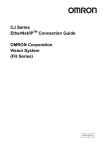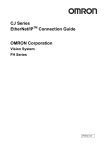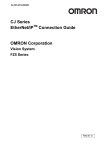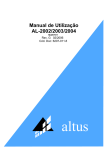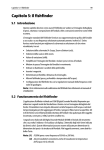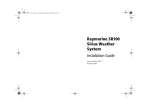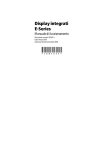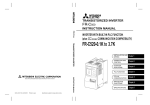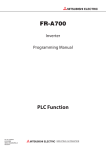Download Raymarine AIS250 User`s guide
Transcript
Raymarine AIS250 Receiver User’s Guide Document Number: 81286_1 Date: February 2007 Trademarks and registered trademarks Autohelm, HSB, Raymarine, RayTech, Sail Pilot, SeaTalk and Sportpilot are registered trademarks of Raymarine Limited. Apelco is a registered trademark of Raymarine Holdings Limited (Registered in all major marketing territories). AST, Autoadapt, Auto GST, Autoseastate, Autotrim, Bidata, Marine Intelligence, Maxiview, On Board, Raychart, Raynav, Raypilot, Raystar, ST40, ST60, Seaclutter, Smart Route, Tridata and Waypoint Navigation are trademarks of Raymarine Limited. All other product names mentioned are trademarks or registered trademarks (if applicable) of their respective companies. © Raymarine plc 2007 Contents i Contents Safety notices....................................................... 1 Important information ............................................ .3 Introduction ....................................................................... Intended use ...................................................................... Compatibility ...................................................................... Warranty ............................................................................ EMC conformance ............................................................. Waste Electrical and Electronic Equipment Directive ........ Restriction of the use of certain Hazardous Substances ... Handbook information........................................................ What is AIS? ...................................................................... Classes of AIS ................................................................... Static and dynamic information.......................................... 3 3 3 4 4 4 4 4 5 5 6 Installation.............................................................. .9 EMC installation guidelines .............................................. 9 Items in the box............................................................... 10 Tools required ................................................................. 10 System configuration ...................................................... 11 Planning the installation .................................................. 11 Receiver........................................................................... 11 Antenna ........................................................................... 12 Cable runs....................................................................... 12 Power cable ..................................................................... 12 Antenna cable.................................................................. 12 Installing the system ....................................................... 13 Receiver........................................................................... 13 Cable connections .......................................................... 14 AIS250 cable connections. .............................................. 14 AIS250 integrated NMEA multiplexer .............................. 15 Power............................................................................... 15 Using the AIS application..................................... .19 Introduction...................................................................... Selecting the correct baud rate for your AIS application . Selecting the AIS function ............................................... AIS status Indicators ........................................................ Setting up AIS ................................................................. How AIS data is displayed?............................................. AIS Target symbols ......................................................... Viewing target information ............................................... AIS safety data................................................................. AIS target list.................................................................... Target list ......................................................................... Full AIS data .................................................................... Using AIS for collision avoidance .................................... Safe zones ....................................................................... Safety messages ............................................................. Simulator.......................................................................... 19 19 19 19 20 21 22 23 23 23 24 24 25 25 26 26 Troubleshooting & Glossary................................. .27 Troubleshooting............................................................... 27 LED sequence................................................................. 28 Glossary .......................................................................... 28 Raymarine World Wide Warranty.......................... .29 1. Product warranty.......................................................... 2. Onboard warranty ........................................................ 3.Obtaining warranty service ........................................... 4. Warranty limitations ..................................................... 31 31 32 33 ii Raymarine AIS250 Receiver - Users Guide Chapter 1: Important information Chapter 1: Important information 3 Disclaimer 1.1 Introduction D10106_1 All information presented by the Raymarine AIS receiver is advisory only. You acknowledge the risk of incomplete and erroneous information and assume complete responsibility and risks associated with this device, and accordingly release Raymarine, Weatherdock and Dommel from any and all claims arising from the use of this service. This guide contains an explanation of how to install, commission, maintain and use your Raymarine AIS250 Receiver. Intended use This product is an Automatic Identification System (AIS) receiver. The intended application is as one component of a navigation system for recreational and commercial vessels not covered by IMO/SOLAS carriage requirements. Compatibility This product has been designed to be compatible with Raymarine C and E-Series products and other systems that support AIS. 4 Raymarine Automatic Identification System Receiver Warranty To register your new Raymarine product, please take a few minutes to fill out the warranty card. It is important that you complete the owner information and return the card to us to receive full warranty benefits. Your product can be registered via our website at www.raymarine.com although this does not validate your warranty. What it does do, is enable you to stay informed of any updates to your current Raymarine products along with any other Raymarine VIP features. You will still be required to fill out the warranty card and return it to us for full warranty benefits. EMC conformance All Raymarine equipment and accessories are designed to best industry standards for use in the recreational marine environment. The design and manufacture of Raymarine equipment and accessories conforms to the appropriate Electromagnetic Compatibility (EMC) standards, but correct installation is required to ensure that performance is not compromised. For full details and guidelines refer to . www.raymarine.com Waste Electrical and Electronic Equipment Directive The Waste Electrical and Electronic Equipment (WEEE) Directive requires the recycling of waste electrical and electronic equipment. Whilst the WEEE Directive does not apply to some of Raymarine’s products, we support its policy and ask you to be aware of how to dispose of this product. The crossed out wheelie bin symbol, illustrated above, and found on our products signifies that this product should not be disposed of in general waste or landfill. Please contact your local dealer, national distributor or Raymarine Technical Services for information on product disposal. Restriction of the use of certain Hazardous Substances RoHS COMPLIANT This product uses components that comply with the requirements of the Restriction of the use of certain Hazardous Substances (RoHS) Directive 2002/95/ EC. Handbook information To the best of our knowledge, the information contained in this handbook was correct as it went to press. Raymarine cannot accept any liability for any inaccuracies or omissions it may contain. In addition, our policy of continuous product improvement may change specifications without notice. As a result, Raymarine cannot accept liability for any differences between the product and this handbook. Chapter 1: Important information What is AIS? AIS permits the non-verbal exchange of navigation information between vessels and shore-side vessel traffic centers. AIS uses digital radio signals to broadcast information about the vessel to other ships and shore based stations via dedicated VHF frequencies in the maritime band. AIS will not replace radar because it is unable to detect landmasses and navigational beacons, but it can be used as a significant enhancement to currently available technology. Classes of AIS Your AIS250 is a receive-only unit that will receive messages from vessels carrying Class A or Class B transceivers. Class A A Class A transceiver transmits and receives AIS signals. It is currently compulsory on all commercial vessels that exceed 300 tons that also travel internationally Information transmitted The following information can be transmitted by a Class A AIS system: • • • Static data This includes information such as Ship’s name, type, MMSI number, call sign, IMO number, length and beam and GPS antenna location. Voyage related data This includes information such as draft, cargo, destination, ETA and other relevant information. Dynamic data 5 This includes information such as time (UTC), ship’s position, COG, SOG, heading, rate of turn and navigational status. • Dynamic reports These are ship’s speed and status. • Messages These are alarms and safety messages. You should remember that not all vessels will transmit all of the information. Class B - (Recreational vessels not covered by suitable Class A) Class B transceiver’s are suitable to vessels under 65 feet in length and is not compulsory. You should NOT assume that any class of AIS receiver is displaying all/any smaller vessels within your range. Note: All messages contain the Ships individual MMSI number for unique reference identification purposes along with the data in the following table. Not all the information in the following table is necessarily transmitted by every vessel. 6 Raymarine Automatic Identification System Receiver Data details Class A Static and dynamic information Class B Defined transmit rates for Class A vessels shown below are provided for reference purposes only. The frequency of messages received (using the AIS250 receive-only unit) will vary due to a number of factors including but not limited to such factors as antenna height, gain and signal interference. Static Data Ship's name Type Call sign • Static information is either broadcast every 6 minutes, when data has been amended, or upon request. • Dynamic information is broadcast depending on speed and course alteration based on the following tables IMO number Length and beam GPS Antenna loctation Voyage Related Data Draft Cargo information Ships Dynamic Conditions Destination ETA Other relevant information At anchor or moored Dynamic Data 0-14 knots Normal reporting interval 3 Minutes 10 Seconds Time 0-14 knots and changing course Ship's position 3 1/3 Seconds COG SOG 14-23 knots 6 Seconds 14-23 knots and changing course 2 seconds Ship faster than 23 knots 2 Seconds Ship faster than 23 knots and changing course 2 Seconds Gyro heading Rate of turn Navigational status Dynamic Reports Ship's speed Ship's status Safety D8966_1 Messages Alarm Chapter 1: Important information Platforms condition 7 Nominal reporting interval Class B Shipborne mobile equipment not moving faster than 2 knots 3 Minutes Class B Shipborne mobile equipment moving 2-14 knots 30 Seconds Class B Shipborne mobile equipment moving 14-23 knots 15 Seconds Class B Shipborne mobile equipment moving faster than 23 knots 5 Seconds Search and Rescue aircraft (airborne mobile equipment) 10 Seconds Aids to Navigation AIS base station 3 Minutes 10 Seconds Source of information for above tables 1-1, 1-2: (ITU recommendations technical document: ITU-R M.1371-1) 8 Raymarine Automatic Identification System Receiver Chapter 2: Installation 9 Chapter 2: Installation 2.1 EMC installation guidelines Raymarine equipment and accessories are designed to the best industry standards for use in the recreational marine environment. Their design and manufacture conforms to the appropriate Electromagnetic Compatibility (EMC) regulations, but correct installation is required to ensure that performance is not compromised. The guidelines given here describe the conditions for optimum EMC performance, but it is recognized that it may not be possible to meet all of these conditions in all situations. To ensure the best possible conditions for EMC performance within the constraints imposed by any location, always ensure the maximum separation possible between different items of electrical equipment. For optimum EMC performance, it is recommended that wherever possible: • • Raymarine equipment and the cables connected to it are: • At least 3 ft. (1 m) from any equipment transmitting or cables carrying radio signals e.g. VHF radios, cables and antennas. In the case of SSB radios, the distance should be increased to 7 ft. (2 m). • More than 7 ft. (2 m) from the path of a radar beam. A radar beam can normally be assumed to spread 20 degrees above and below the radiating element. The product is supplied by a separate battery from that used to start the engine. Power supply voltages below the • minimum specified for a product, and starter motor transients, can cause the product to reset. This will not damage the product, but may cause the loss of some information and may change the operating mode. Raymarine specified cables are used. Cutting and rejoining these cables can compromise EMC performance and must be avoided unless doing so is detailed in the installation manual. Suppression Ferrites If a supplied cable is fitted with a suppression ferrite, the ferrite must not be removed, unless it is necessary to facilitate installation. Any ferrite thus removed must be replaced in the original position immediately after installation is complete. If additional suppression ferrites are required, use only ferrites supplied by Raymarine. Connections to Other Equipment If Raymarine equipment is to be connected to other equipment using a cable not supplied by Raymarine, a Raymarine suppression ferrite MUST always be attached to the cable near the Raymarine unit. 10 Raymarine Automatic Identification System Receiver 2.2 Items in the box 4 ft. (1.2 m) AIS to VHF Antenna connector cable (x2) Screw - N 8 x 3/4" (4 x 20 mm) O 5 ft. (1.5 m) Power cable AIS250 receiver module D10105_1 2.3 Tools required Drill 1/4" (3.2mm) Drill bit Phillips screwdriver D10103_1 Chapter 2: Installation 11 2.4 System configuration Receiver The illustration below shows a basic installation for an AIS system: GPS antenna VHF radio Warning: Potential Ignition Source! This product is NOT approved for use where hazardous/flammable atmospheres could occur, e.g. an engine room. MAX 55 130 MIN -10 14 Protect the receiver from extremes of temperature. DO NOT place the receiver near an engine, or where fuel vapor could be present. VHF antenna NMEA Data 4.8 in/out Multifunction display AIS250 receiver DO NOT install the receiver where it is likely to get wet or where it can be splashed with water. PAGE ACTIVE WPTS MOB DATA MENU OUT RANGE IN OK CANCEL FM radio NMEA 38.4 IN/OUT SeaTalk D9983_1 DO NOT install the receiver where it can be kicked or trodden on. 2.5 Planning the installation When planning the installation and choosing locations for the antenna and receiver, consider the following points: D9063-1 You should choose an installation site where the power cable can be easily removed from the unit. 12 Raymarine Automatic Identification System Receiver Antenna Your Raymarine AIS receiver does not strictly require a dedicated antenna. The on-board antenna splitter enables you to connect your existing VHF radio antenna to your AIS receiver and then connect from the AIS250 to your VHF. However in doing so you may experience some level of degradation to your VHF’s receiving performance. A separate VHF antenna is recommended if you wish to maintain the same performance. 2.6 Cable runs Caution: DO NOT cut cables or remove connectors as this will severely reduce system performance. If a longer cable is required you will need to purchase a replacement cable from a suitable dealer. In the event a shorter cable length is required, secure excess cable out of the way. Consider the following points before installing the system cables: • • • • You may need to connect the antenna cable and the antenna connector cable from the AIS250 receiver to your VHF radio. So ensure enough room is allowed to comfortably insert and remove connectors from the unit. All cables should be adequately protected from physical damage and exposure to heat. Avoid passing cables through bilges or doorways, or close to moving or hot objects. Acute bends and squashing of the cable must be avoided. • • Where a cable passes through an exposed bulkhead or deckhead, a watertight gland or swan neck tube should be used. DO NOT pull cables through bulkheads using a cord attached to the connector. This could damage the connector. You will need to run the following cables: • • 1.5 m (5 ft.) Power cable. 1.2 m (4 ft.) AIS250 to VHF radio connector cable (enables you to use the existing VHF antenna cable). Power cable A 5 ft. (1.5 m) power cable is supplied, and must be protected by a 1.0A resettable fuse/circuit breaker Antenna cable A 4 ft. (1.2 m) AIS250 to VHF cable is supplied. (This allows you to use your existing VHF antenna for dual purpose, i.e. AIS250 & VHF reception). Chapter 2: Installation 13 2.7 Installing the system The following section gives details of how to install your Raymarine AIS receiver and antenna. Check Receiver 6" D10120_1 A Minimum space of six inches is to be left under the unit to allow adequate room for cable bends/connections and removals. Drilling Check x2 Check Ver t D10104_1 ica l x2 D8584-1 The receiver should be installed a minimum of 3 ft. (1m) away from an engine, compass or any magnetic device. Drill guide holes for the fixing screws. 14 Raymarine Automatic Identification System Receiver Mounting 1 3 2 D8585-1 m 6 m um im min Part fit screws, situate the unit, then tighten fully. 2.8 Cable connections AIS250 cable connections. VHF RADIO VHF ANTENNA FM RADIO TX AIS ON NMEA 38.4 NMEA 38.4 NMEA 4.8 NMEA 4.8 OUT IN OUT IN POWER D10107-1 Picture of the AIS250 connections as shown above. Chapter 2: Installation 15 AIS250 integrated NMEA multiplexer Cross track error. This data is passed back to the AIS receiver to be transmitted to a connected NMEA 0183 4.8 kbaud device such as a DSC radio or Autopilot via the “NMEA 4.8 OUT” port. NMEA 38.4 NMEA 38.4 NMEA 4.8 NMEA 4.8 OUT IN OUT IN POWER 10188_1 Both 38.4 kbaud IN/OUT ports are connected to the single NMEA 0183 port on either a C or E-series multifunctional display with the connected NMEA port configured to 38400. The AIS250 has an internal multiplexer (baud rate converter) allowing the integration of an additional NMEA 0183 device to your multifunctional display. Note: All NMEA ports operate NMEA 0183 interface standards, operating at different baud rates. See NMEA 0183 technical specification for details. Your AIS250 unit has 2 NMEA ports. • 34.8 kbaud IN/OUT • 4.8 kbaud IN/OUT From left to right the ports are labelled as follows: NMEA 38.4 OUT: This port outputs received AIS data to your NMEA compatible multifunction display*. This port will also multiplex and output buffered data from the “NMEA 4.8 IN” port. Important: The multifunctional display’s NMEA baud rate must be configured for “AIS 38400” for correct operation see individual display’s user manual for correct procedure. NB: Your multifunctional display may require a software upgrade to enable this feature. NMEA 4.8 OUT: This port allows devices requiring NMEA 0183 data running at 4.8 kbaud as their input to integrate into the NMEA network. Typically a DSC radio’s or a 3rd party non-Raymarine Autopilot’s NMEA input would connect to this port. NMEA 4.8 IN: This port allows the integration of an external NMEA device such as a fast heading sensor, NMEA GPS or other NMEA 0183 compatible device to communicate with the connected display via 4.8 kbaud data which is multiplexed and sent via the 38.4 kbaud OUT port. If you have multiple NMEA 0183 4.8 kbaud devices, the Raymarine NMEA multiplexer (p/n E55059) may be used. The output from the multiplexer connects to this port. Power NMEA 38.4 IN: This port connects to your power supply to provide power to your AIS250 receiver. This port allows NMEA sentences from your multifunctional display such as GPS location, Autopilot route information i.e. * it is important to note the received AIS data is ONLY output to the 38.4 kbaud port and NOT to the 4.8 kbaud port. 16 Raymarine Automatic Identification System Receiver 17 Appendix A: Technical specification Receiver General Connectors Environmental Waterproof Operating range Storage range Humidity IPX2 -10oC to 55oC (14o to 131o F) -20oC to 75oC (-4oF to 167oF) up to 95% at 35oC noncondensing Receiver Size 8.6” x 6.7” x 2.5” (218.8 x 170.5 x 61.7 mm) Weight 0.5 Kg Mounting Two key-holed mounting tabs, screws Power Voltage Reverse polarity protected 12 V to 24 V DC (-10% to +30%) Performance Operating frequencies Channel spacing Sensitivity Data rate Antenna impedance Baud rate Format NMEA telegramme VHF In/Out FM Out Power NMEA 0183 161.975 and 162.025 MHz 25 kHz < -109 dBm (receiver only) 9600 BpS 50 Ohm 38.4 kB/sec. (38,400) 4.8 kB/sec. (4,800) NMEA0183 VDM 18 Raymarine AIS250 Receiver - Users Guide Chapter 2: Using the AIS application Chapter 2: Using the AIS application This chapter is intended to give an overview of how to operate the AIS application on your C or E-Series display. This information is correct on the date of print. Note: Ensure you have the latest up to date version of the user handbook for your individual Display (C/E-Series) which can be accessed on-line at www.raymarine.com look for Owner’s Manuals under Customer Support. 2.1 Introduction This is to show how the Automatic Identification System (AIS) receiver, is used as part of a Raymarine multifunction display system. Once set up you can overlay the AIS on chart or radar pages and use it to: • • • • Display a target (with heading/speed vectors and rate of turn) for any Class A or Class B AIS equipped vessels within range. Display basic or detailed information for each target vessel Set up a safe zone around your boat. View alarm and safety related messages. 2.2 Selecting the correct baud rate for your AIS application Firstly ensure you have the correct version of software (Menu/ System Diagnostics/Software Services/Unit Info App Version) which should be V3.00 or above for both E and CSeries. To ensure your AIS unit operates correctly it requires user interaction. You must set the baud rate to “AIS 38400” in the MFD system set up menu to do this select: • • • • • • 19 Menu System Setup System Integration NMEA Port Setting AIS 38400 Select OK 2.3 Selecting the AIS function AIS information is shown as a layer on the chart or radar application of your system. To display AIS... ...with the charting page activated 1. Press Presentation soft key. A set of Presentation soft keys will appear. 2. Press Chart Layers. The Chart Layers soft keys appear. 3. Toggle AIS Layer to ON. ...with the radar application 1. Press Presentation soft key. A set of Presentation soft keys will appear. 2. Toggle AIS Layer to ON. AIS status Indicators The status of the AIS is displayed in the data bar on your display. 20 Raymarine Automatic Identification System Receiver Setup Chart Setup... Cartography Setup... No AIS targets are being received. GPS Status... Compass Setup... AIS Layer Setup 1.Press MENU. The Setup dialog box appears. 2.Press trackpad Up/Down to highlight AIS Layer Setup. 3.Press trackpad Right. The AIS Layer Setup dialog box appears. AIS targets are being received AIS Layer Setup AIS targets are within range with active alarm. AIS targets are within range but dangerous and lost target alarm is OFF. If your own boat’s position is lost the display will disable the AIS functionality and will display the ‘No AIS’ icon. Once your own boat’s position returns and the AIS display is switched on, the display will re-enable the AIS function. 2.4 Setting up AIS The AIS Layer Setup Menu enables you to: • • • Select the target types displayed (ALL or DANGEROUS) Switch the display of AIS safety messages ON/OFF. View the list of active AIS unit alarms. To display the AIS Layer Setup Menu: Note: (Ensure the AIS unit is operational and has a fix). Displayed Target Types AIS Safety Messages AIS Alarms List... 4. 5. 6. 7. All ON Press trackpad Up/Down to highlight feature. Press trackpad Right. The feature options appear. Press trackpad Up/Down to change feature option. Press OK. The selection is accepted. Chapter 2: Using the AIS application 21 2.5 How AIS data is displayed? Heading Large vessel Direction of turn Small vessel 097˚T 11.6kt 1.2 37nm 00h04m33s Safety critical data COG/SOG vector Your AIS system displays AIS targets in the surrounding area as triangular shapes overlaid on a chart or radar page. Up to 100 targets are displayed. As the vessel’s status changes, the symbol for the target will change accordingly. Vectors can be displayed for each target. These vectors indicate the direction of travel and rate of turn of the vessel and the distance it will travel over a specified period of time (COG/SOG vector). Targets displayed with their vectors are referred to as Safe zone (defined by distance or time) Dangerous target (flashes) D9056_1 Sleeping target ‘active targets’ and are scaled according to the size of the vessel. The larger the vessel the larger the target. You can either display all targets or just dangerous targets.(See Page 23.) 22 Raymarine Automatic Identification System Receiver 2.6 AIS Target symbols Sleeping target • Target not activated, dangerous or lost. Activated target • Target is active with AIS vector displayed showing predicted distance travelled within a given time. Selected target • Target has been selected with the cursor and can now be activated and data shown. AIS Dangerous target • Target is within a specified distance (closest point of approach -CPA) or time (time to closest point of approach - TCPA). Uncertain target • Calculated CPA or TCPA value is uncertain. Lost target • Dangerous target signal not received for 20 seconds. • Shows target in last predicted position. • Alarm will sound if enabled. • Target icon flashes. Chapter 2: Using the AIS application Viewing target information You can display information relating to AIS targets, this can be individual or all targets information. When a target is highlighted with the cursor, the soft keys change to allow you to select the following options: • • • AIS vectors. AIS safety data. Full AIS data. AIS vectors A target is defined as active when it has the following data displayed graphically: COG/SOG vector Direction of turn Heading •A COG/SOG vector indicating the predicted distance that a target will travel within a given period of time. •A heading and direction of turn indicator. 23 AIS safety data 1870T 10.9kt 7.719nm 00h57m27s Safety target data is displayed in a tag alongside each target. The data shown is: •COG. •SOG. •CPA. •TCPA You can switch this data ON, OFF or display it automatically (AUTO) when the cursor is over the target. To set AIS safety data status: 1. Press trackpad to move the cursor over the relevant target. 2. Toggle AIS softkey to required status Auto, ON or OFF. AIS target list When a target is activated, its symbol is scaled according to the size of the vessel. The same target vector and safe zone settings apply to both radar MARPA and AIS targets To switch the AIS VECTOR option ON/OFF: 1. Press trackpad to move the cursor over the relevant target. 2. Toggle AIS VECTOR to ON. The AIS target list provides information on all targets being tracked. The target list dialog box is divided into two parts: 24 • • Raymarine Automatic Identification System Receiver Target list. Target information. Full AIS data Target list The target list shows all targets being tracked. It gives each target a number and shows the boat’s name, its MMSI number, range and bearing. You can scroll through this list and highlight a specific target. Target information When you select a target on the target list, the lower part of the dialog box shows additional information on the selected target. To show the AIS target list: 1. Press AIS OPTIONS. The AIS options soft keys appear. 2. Press TARGET TRACKING. 3. Press AIS LIST. You can also show full data for a selected target. To show full AIS data: 1. Press trackpad to move cursor over the relevant target. 2. Press VIEW FULL AIS DATA. The AIS data box appears. or, with the AIS target list displayed: 1. Scroll and highlight the relevant target in the list. 2. Press VIEW FULL AIS DATA. The AIS data box appears. Chapter 2: Using the AIS application 2.7 Using AIS for collision avoidance Your AIS system can help with collision avoidance using the following functions: • • Safe zones. Safety messages. Safe zones A safe zone is a red ring displayed on radar and/or chart pages around your boat. Targets that come within this ring are considered dangerous. An AIS safe zone uses the same criteria as MARPA to determine a targets status. A target is considered dangerous if it comes within the CPA or TCPA of your boat. The CPA and TCPA are calculated using COG/SOG and position from the AIS target. When your system recognizes a dangerous AIS target: • The target symbol changes to red and flashes. • An alarm pop-up is displayed. • An alarm sounds. With your AIS receiver connected and functioning, the system continually checks for dangerous targets within the safe zone and sounds an alarm if enabled, when necessary. However, the dangerous target alarm operates irrespective of the AIS target display or safe zone ring status. 25 To set up an AIS safe zone: 1. Select AIS Options 2. Press TARGET TRACKING. The AIS options soft keys appear. 3. Press MARPA & AIS OPTIONS. The MARPA and AIS options dialog box appears. MARPA and AIS options Parameter Options (Default in bold) Vector Length The distance the vessel will travel in the selected time period, at current COG & SOG 0.5min, 1 min, 3 min, 6min, 12min, 30 min, 60 min Target History Plots a MARPA target’s previous position at specified intervals. The four most recent position points are displayed. If True target vectors are selected, the four most recent vessel position points are also displayed. OFF, 0.5 min, 1 min, 3 min, 6 min 26 Raymarine Automatic Identification System Receiver Parameter Own vessel safe zone The safe zone is a ring, centred on your boat, within which a target is considered dangerous if it comes within a specified distance. Options (Default in bold) 0.1 nm, 0.2nm, 0.5nm, 1.0 nm, 2.0nm • Place a waypoint on your chart/radar to mark the sending vessel’s position. Select to GOTO the sending vessel’s position. Note: When the simulator is operating you will not be able to receive any safety messages. Simulator We recommend that you use the simulator to familiarize yourself with the AIS function. Time to safe zone If a target enters your safe zone within this time period, it is considered dangerous. 3 mins, 6 mins, 12 mins, 24 mins Safe zone ring Controls whether the safe zone ring is displayed or hidden on screen Visible Hidden Safety messages When the status of the AIS Safety Messages function is set to ON in the AIS Layer Setup Menu (see page 20), any incoming safety messages from surrounding vessels, shore stations and mobile stations, are displayed in a pop-up box. If known, the message will include the sending vessel’s position as latitude and longitude. Using the softkeys you now have the option to: • • Remove the message (ACKNOWLEDGE) When the system simulator is switched on your Raymarine display, it will display 20 AIS targets within a 25nm range. These targets are displayed using the appropriate AIS targets status symbol (see page 22) and move around the screen as if they were real targets. Important: Incoming safety messages cannot be displayed while the simulator is switched on. Chapter 3: Troubleshooting & Glossary 27 Chapter 3: Troubleshooting & Glossary 3.1 Troubleshooting Here we will detail any potential issues possible. Issue How to Solve •No Power •Check all power connections and that power is applied at correct voltages and currents, also check any relevant Fuses. •No Data • Check all connections are made at both ends of the cable. • Check VHF aerial lead is connected (can you send receive VHF radio information)? •No Vessel Data • Place the cursor over the targeted vessel and ensure the ‘AIS DATA’ softkey is not selected as OFF! • Select the presentation softkey, then chart layers softkey, AIS layer needs to be set to ‘on’. • Select the menu button, AIS layer setup menu, displayed target types should be set to ‘all’ if it was previously set to ‘dangerous’. Issue How to Solve •No AIS data present •Check the AIS input wires are correctly orientated from the multifunctional displays NMEA output. •Ensure that the Displays NMEA output is correctly set to 38.4kbaud 28 Raymarine Automatic Identification System Receiver 3.2 LED sequence 3.3 Glossary This section is here to describe how we use the LED’s. LED LED Color LED Status •TX (Transmit) •Yellow •Illuminates when VHF transmits. •AIS •Red •Illuminates when data is received. •ON •Green •Solid Green if power is present on the unit. Term Definition •COG •Course Over Ground - used as a GPS related term •SOG •Speed Over Ground - used as a GPS related term •CPA •Closest Point of Approach (An estimation of the closest a target will potentially come to you) •TCPA •Time to Closest Point of Approach (How long before target reaches that point) •AIS •Automatic Identification System •MMSI •Maritime Mobile Service Identity •IMO •International Maritime Organization •MARPA •Miniature Automated Radar Plotting Aid •SOLAS •The International Convention for the Safety Of Life At Sea. (This is a treaty protecting the safety of merchant ships). Chapter 4: Raymarine World Wide Warranty Chapter 4: Raymarine World Wide Warranty Raymarine Inc. APPLICABLE TO PRODUCTS SOLD THROUGH OFFICIAL RAYMARINE INC. DEALERS, DISTRIBUTORS AND BOAT BUILDERS WITHIN THE AMERICAS AND CARIBBEAN. Limited warranty Subject to the terms, conditions and limitations set forth in this U.S. Limited Warranty (hereinafter the ‘Warranty’), Raymarine warrants that its products, when properly installed and used, will be free from defects in material and workmanship for a period of twenty-four (24) months (with respect to VHF radios - a period of thirty-six (36) months), from the date of first purchase (the ‘Warranty Period’). For the purposes of this warranty, ‘date of first purchase’ means the date that the product was purchased by the first retail customer; or in the case of a product installed on a new vessel by a certified Raymarine original equipment manufacturer (a ‘Raymarine OEM’), the date that such vessel was purchased by the first retail customer. Raymarine will, at its sole option, repair or replace any defective products or components returned during the Warranty Period in accordance with the terms, conditions and limitations set forth below. Such repairs or replacement will be the sole remedy of the customer under this Warranty. 29 Obtaining Warranty Service Standard War ranty Ser vice To qualify for standard warranty service the product must be returned to a Raymarine-certified service agent, or directly to Raymarine in person, or by mail (i) within the Warranty Period, and (ii) within thirty (30) days of the alleged product failure.Any products returned by mail must be securely packaged and sent pre-paid and insured to Raymarine or to a Raymarine-certified service agent. All products, whether returned in person or by mail, must be accompanied by a copy of the original sales receipt, to be eligible for standard warranty service. A list of Raymarine-certified service agents is available from Raymarine Technical Support or at www.raymarine.com ‘On Board’ Warranty Service For any Raymarine product or system that (i) has been installed on your vessel by a Raymarine-certified service agent or by a Raymarine OEM, and (ii) has a MSRP equal to or greater than USD $2,500, you are eligible to receive warranty service by a Raymarine certified service agent on-board your vessel (‘On Board Warranty Service’) for a period of 12 months from the date of first purchase of such product or system, or the date of first purchase of the vessel on which such product or system has been installed (the ‘On Board Warranty Period’). In order to obtain On Board Warranty Service eligible customers MUST: • (i) within the On Board Warranty Period, and (ii) within thirty (30) days from the date of the alleged failure giving rise to the warranty claim for which you are requesting On Board 30 Raymarine Automatic Identification System Receiver Warranty Service, contact a local Raymarine-certified service agent and request On Board Warranty Service. • Present to the Raymarine-certified service agent a copy of the original sales receipt for the product, together with proof of the date of installation of the product by a Raymarine-certified service agent. The service agent may at its sole option, accept or deny such proof of purchase and proof of installation as sufficient to qualify you for On Board Warranty Service. Costs associated with travel, mileage, taxi fares, launch or docking fees, aircraft or vehicle rental, meals, customs, shipping, communication charges, and service agent travel costs are specifically excluded from coverage under this Warranty and are your responsibility. In addition, this Warranty does not cover fees associated with hauling, shipping or towing your vessel to a Raymarine-certified agent. • Upon the expiration of the On Board Warranty Period, you are still eligible to receive standard warranty service for the remaining term of the Warranty Period, but will not be eligible for continued On Board Warranty Service. Other conditions Limitations and Exclusions In addition to any other limitations and exclusions set forth herein, Raymarine is not responsible for, and this Warranty does not cover: • failures due to abuse, misuse, accident, unauthorized alteration or repair, improper installation (whether or not by a Raymarine-certified service agent), shipping damage or corrosion; • • • • • Costs associated with routine system checkouts, alignment/ calibration, seatrials or commissioning; repair or replacement of consumable items, including, without limitation, fuses, batteries, drive belts, radar mixer diodes, snap-in impeller carriers, impellers, impeller bearings and impeller shafts; costs associated with overtime or premium labor costs; differences in material, coloring or size that may exist between actual products and the pictures or descriptions of such products in our advertising, advertising literature or on the Internet; products purchased by a customer from a United States dealer via the Internet if such products were not delivered and installed within the United States; or the replacement of missing components from the package of any product purchased through an online auction site. This Warranty is fully transferable provided that you furnish the original proof of purchase to Raymarine or, in the case of On Board Warranty Service, to a Raymarine-certified service agent. This Warranty is void if the label bearing the serial number has been removed or defaced. TO THE EXTENT CONSISTENT WITH STATE AND FEDERAL LAW, THE FOREGOING WARRANTY IS RAYMARINE’S SOLE WARRANTY AND IS APPLICABLE ONLY TO NEW PRODUCTS PURCHASED IN THE UNITED STATES OF AMERICA. THE PROVISIONS OF THIS WARRANTY ARE IN LIEU OF ANY OTHER WRITTEN WARRANTY, WHETHER EXPRESSED OR IMPLIED, WRITTEN OR ORAL, INCLUDING Chapter 4: Raymarine World Wide Warranty ANY WARRANTY OF MERCHANTABILITY OR FITNESS FOR A PARTICULAR PURPOSE. THE LIABILITY OF RAYMARINE TO A CUSTOMER UNDER THIS WARRANTY, WHETHER FOR BREACH OF CONTRACT, TORT, BREACH OF STATUTORY DUTY OR OTHERWISE SHALL IN NO EVENT EXCEED AN AMOUNT EQUAL TO TEN (10) TIMES THE MANUFACTURER’S SUGGESTED RETAIL PRICE OF THE PRODUCT GIVING RISE TO SUCH LIABILITY AND IN NO EVENT SHALL RAYMARINE BE LIABLE FOR SPECIAL, INCIDENTAL, CONSEQUENTIAL OR INDIRECT DAMAGES. SOME JURISDICTIONS DO NOT ALLOW EXCLUSION OR LIMITATION OF INCIDENTAL OR CONSEQUENTIAL DAMAGES SO THE ABOVE LIMITATIONS OR EXCLUSIONS MAY NOT APPLY TO YOU. THIS WARRANTY GIVES YOU SPECIFIC LEGAL RIGHTS AND YOU MAY ALSO HAVE OTHER RIGHTS, WHICH VARY FROM JURISDICTION TO JURISDICTION. This Warranty supersedes and replaces all previous Warranties. January 2005 Raymarine UK Ltd APPLICABLE TO PRODUCT SOLD THROUGH OFFICIAL RAYMARINE UK LTD. DEALERS, DISTRIBUTORS AND BOAT BUILDERS WITHIN EUROPE, THE MIDDLE AND FAR EAST, AFRICA AND AUSTRALASIA. Limited Warranty The Raymarine warranty terms and conditions as described below do not affect the customers legal rights and complies with EU Directive 1999/44/EC. 31 In order to ensure that the product continues to operate efficiently and reliably, we recommend that, before using the product, the customer carefully reads the Owner’s Handbook and follows the advice on the safe and correct operation and use of the product. We recommend that the Raymarine product is installed by a Raymarine certified installer. Installation by persons other than a Raymarine certified installer may invalidate the warranty. 1. Product warranty 1.1 Raymarine warrants each new product to be of good materials and workmanship. Raymarine, or its approved agents, will repair or exchange under warranty any parts or product proven to be defective in material or workmanship under normal use, for a period of 2 years (24 months) from date of sale to end user, subject to the limits contained in this warranty document. 1.2 The Raymarine warranty covers the parts and labour associated with any warranty repair as described above, provided that the product is returned to Raymarine or one of its approved agents. 1.3 Raymarine reserve the right to replace under warranty, not repair, certain Raymarine products subject to the limitations below, provided that they are returned to the nearest Raymarine National Distributor. For details of such products refer to the internet at www.raymarine.com or contact your nearest Raymarine National Distributor. 2. Onboard warranty 2.1 In addition to the Product warranty cover as described above, Raymarine will, authorize onboard warranty service by the nearest Raymarine approved service agent, subject to the maximum mileage and other limits referred to in paragraph 4.12 32 below, on products, where proof of installation, or commission by Raymarine certified installers, can be shown. 2.2 The warranty provides for onboard repair or exchange of the product, by Raymarine or its approved service agents, for a period of 2 years (24 months), subject to the limits contained in this warranty document. In the case of a product installed, by a Raymarine certified OEM installer, on a new boat prior to the sale of the boat to a customer, the 2-year period will begin on the date of the sale of the boat to the customer. In the case of a product installed, by a Raymarine certified installer, on a boat already in the possession of the customer, the 2-year period will begin on the date of the commissioning of the installed product. 2.3 Certain Raymarine products are not covered by onboard warranty unless the products are pre-registered and on board warranty is purchased from the Raymarine certified installer. For details of such products refer to the internet at www.raymarine.com or contact your nearest Raymarine National Distributor. 2.4 The Purchaseable onboard warranty is subject to the limitations below. Raymarine Automatic Identification System Receiver i.e. Product warranty, the affected product must be returned to the customer’s local Raymarine approved service agent or direct to Raymarine with: 3.2.1 proof of purchase showing the date of purchase and the name of the supplier of the product; and 3.2.2 the serial number of the affected product; or 3.2.3 a warranty card completed by the product supplier (which will contain the information required by paragraphs 3.2.1 and 3.2.2). Subject to the limitations below, the product will be repaired or replaced (at the discretion of Raymarine or a Raymarine Service Agent) at no further cost and promptly returned to the customer. 3.3 In cases where the customer is making a warranty claim and the product has been installed by a Raymarine certified installer, (boat builder, installer, dealer etc.) i.e. Onboard warranty, the nearest Raymarine approved service agent should be contacted and onboard service requested (which will be subject to the limits referred to in paragraph 4.12 below). Before the onboard warranty service is performed, the customer must have available: 3.Obtaining warranty service 3.3.1 proof of purchase showing the date of purchase and the name of the supplier of the product; and 3.1 In the event of warranty service being required, the customer should contact Raymarine Technical Support or the nearest Raymarine approved service agent - the contact details of Raymarine Technical Support and a full list of the names and details of worldwide service agents are available on the internet at www.raymarine.com and in the Owner’s Handbook. 3.3.2 the serial number of the affected product; or 3.2 In cases where the customer is requesting a warranty service and a Raymarine certified installer has not installed the product; 3.3.3 proof of installation of the product by a Raymarine certified installer; or 3.3.4 a warranty card completed by the product supplier (which will contain the information required by paragraphs 3.3.1 and 3.3.3). Chapter 4: Raymarine World Wide Warranty 3.4 In cases where onboard warranty has been purchased - as described in 2.3; the nearest Raymarine approved service agent should be contacted and onboard service requested, information detailed in 3.3.1 and 3.3.2 is required. Onboard warranty service will only be performed if the product serial number confirms that the onboard warranty service has been purchased and is valid. 4. Warranty limitations 4.1 Raymarine warranty policy does not apply to any product that has been subjected to accident, abuse or misuse, shipping damage, alterations, corrosion, incorrect and/or non-authorized service, or products on which the serial number has been altered, mutilated or removed. 4.2 Certain products do not carry the onboard warranty, as described in section 2 above, unless the onboard warranty cover is purchased at the time of installation. The purchaseable onboard warranty is only available on products purchased in specific territories, for further details refer to the internet at www.raymarine.com or contact your nearest Raymarine National Distributor. 4.3 Products purchased outside the country of installation will not be covered by onboard warranty. 4.4 Raymarine assumes no responsibility for damage incurred during installation or as a result of improper installation. 4.5 This warranty does not cover routine system checkouts, alignment/calibration, seatrials or commissioning, unless required by replacement of part(s) in the area being aligned. 4.6 Raymarine assumes no responsibility for damage caused by or to other equipment, systems or components occasioned by improper or unauthorized connection, or use, of the product. 33 4.7 Consumable items, including, but not limited to: fuses, batteries, drive belts, radar mixer diodes, snap-in impeller carriers, impellers, impeller bearings, and impeller shafts are specifically excluded from this warranty. A complete list of the consumable items relating to each product can be found in the Owner’s Handbook and/or on the internet at www.raymarine.com. 4.8 All costs associated with transducer replacement, other than the cost of the transducer itself, are specifically excluded from this warranty. 4.9 Overtime/premium labour portion of services outside of normal working hours is not covered by this warranty. 4.10 If repairs are necessary under the warranty, the affected product must be forwarded to a Raymarine facility or a Raymarine approved service agent, at the owner’s expense. 4.11 The Raymarine warranty does not cover any differences in material, coloring or size between those alluded to in corporate advertising, literature or published on the internet, which are not specifically objected to at the time of delivery. 4.12 Travel costs other than auto mileage, tolls and two (2) hours travel time, are specifically excluded from the warranty on all products. Costs, which are excluded from the coverage of this warranty, include but are not limited to; taxi fares, launch fees, aircraft rental, subsistence, customs, shipping, and communications charges etc. 4.13 Neither Raymarine nor a Raymarine service agent shall be liable for any incidental, indirect, consequential or special (including punitive or multiple) damages, nor shall Raymarine or a Raymarine service agent be liable for any loss of profit, business, contracts, opportunity, goodwill or other similar loss. The liability of Raymarine or a Raymarine service agent to a customer under this 34 warranty, whether for breach of contract, tort, breach of statutory duty or otherwise, shall not exceed US$1,000,000. Nothing in this paragraph 4.13 shall limit the liability of Raymarine or a Raymarine service agent in respect of death or personal injury caused by its negligence, fraud or any other liability which by law, cannot be excluded or limited. 4.14 All Raymarine products sold or provided hereunder are merely aids to navigation. It is the responsibility of the user to exercise discretion and proper navigational skill independent of any Raymarine product. Document Number 80011_1 March 2007 Raymarine Automatic Identification System Receiver Chapter 4: Raymarine World Wide Warranty 35 Raymarine Service Centers Complete product information and interactive help is available at: www.raymarine.com North and South America Europe, Middle East, Africa and Australasia Raymarine Technical Support +1 603-881-5200 Raymarine Technical Support +44 (0) 23 9271 4713 Product Repair and Service Raymarine plc Anchorage Park Portsmouth PO3 5TD England Help us to help you To allow us to respond to your needs faster, please quote the Equipment type, Model number and Serial number when requesting service D8033-1 Product Repair and Service Raymarine Product Repair Center 21 Manchester Street, Merrimack, NH 03054-4801 USA 36 Raymarine Automatic Identification System Receiver Stick barcode label here Purchased from Purchase date Dealer address Installed by Installation date Commissioned by Commissioning date Owners name Mailing address






































